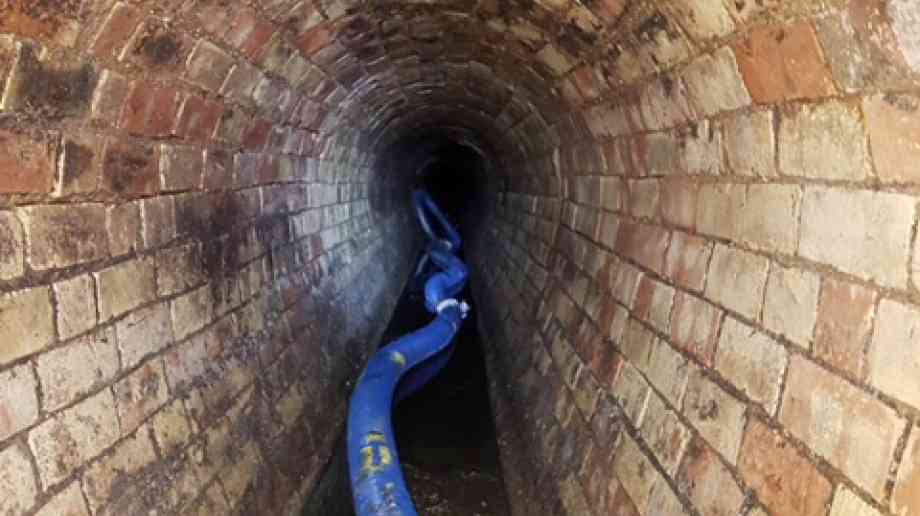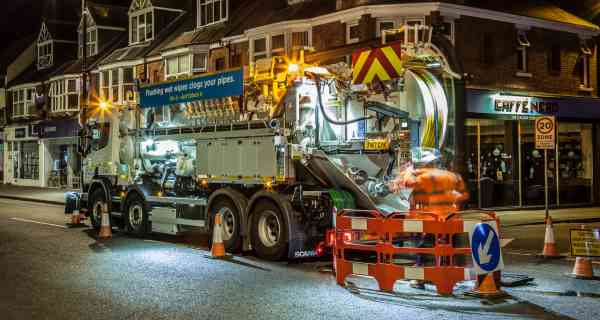Sue Robb of 4Children talks to Julie Laughton and Alison Britton from the Department for Education about the role of childminders in delivering the 30 hours free entitlement.

Keeping the UK flowing
A jet vac tanker was recently used in London to tackle the Whitechapel fatberg, which gained notoriety around the world. On behalf of the Water Jetting Association, Richard Leigh looks at the use of water jetting systems in cleaning and maintaining water works
Water jetting has become ubiquitous. You can have your car pulverised clean in minutes at the local hand car wash centre. Then drive to a DIY store to select a pressure washer that blasts out water at nearly 1,900psi (130bar) to vaporise grime from your patio. This water jetting technology has been made possible by technical advances that have transformed the way many asset maintenance tasks are now carried out in the commercial, utility and public service sectors.
Advances in water jetting technology are allowing sewers and culverts to be cleaned more quickly and efficiently than ever before. It is at the forefront of surface water maintenance programmes designed to reduce flooding risks. It is providing a sustainable method for tackling the biggest current utility challenges, like fatbergs. It is also playing a key role in supporting wider infrastructure projects, such as Smart Motorways, and the upgrading of our rail system.
Cleaning, stripping, and cutting
Water jetting has evolved over the last 50 years. Apart from the home pressure washer systems, already mentioned, perhaps the most visible application is in drain and sewer cleaning and unblocking. Here, water jetting is combined with vacuumation technology. Water jets are used to clean and unblock pipes. Vacuumation systems then suck up the waste, for disposal at authorised sites.
Water jetting is used for many other industrial tasks like surface cleaning, such as de-greasing machinery in factories, and industrial tank cleaning. It strips specialist coatings and paint as part of planned maintenance, as seen on oil rigs and ships. It is also used for materials cutting, including concrete, stone, asphalt, and steel, especially where micro-cracking and fracturing in concrete could be caused by using mechanical methods, and where fire risks need to be mitigated.
Disaster drives innovation
Water jetting for sewer and drainage cleaning developed particularly rapidly from the early 1990s onwards. The trigger was, in part, a series of major floods, which highlighted the poor condition of storm water drains and culverts. Government agencies could see a clear need to improve the maintenance of these flood alleviation assets. Making the best use of the advances in jet vac technology, then coming onto the market, was an important part of the solution.
Local flood authorities enhanced their surface water culvert cleaning programmes still further in the wake of more recent flood events, notably the winter floods of 2013-14 and 2015-16. Water jetting has been the prime method for carrying out this work.
Concern about climate change caused by global warming is also informing strategic drainage maintenance plans. In July, the Met Office published results of research which indicated there is a one in three chance of a new monthly rainfall record in at least one region each winter in the UK. The study, carried out as part of the National Flood Resilience Review, has led some climate change experts to call for yet more resources to be put in to controlling surface water flooding.
Water jetting workhorse
The main water jetting workhorse in the drainage and utility industries is the jet vac tanker. These carry a supply of water – from around 4,000 litres to 15,000 litres, extracting water from hydrants.
Their jetting hoses can be anything up to 300 metres long. The hose run can be extended, including using tracked or wheeled remotely-powered hose-reel units for reaching off-road areas.
A wide range of jetting nozzles can be fitted for different tasks, including jetting through heavy sludge, descaling pipes and cutting through tree roots that infest many pipes.
Directional water pressure is used to propel the jetting hose along a pipe. When it reaches a blockage, jets of water, at around 2,500psi (172bar), are used to obliterate it. Then, the jetting direction is reversed, to drag the waste back to the manhole, where it can be sucked into the jet vac tank.
Water jetting has significant benefits, including: allowing fast cleaning and unblocking of long runs of drains, sewers and culverts; preventing the need for drainage engineers to enter sewers, so significantly enhances safety; the latest jetting systems are a major contributor to sustainable utility maintenance, by recycling water; and dramatically increasing the productivity of water utility maintenance.
No dig drain maintenance
Water jetting is a core element of no dig technologies that have transformed the maintenance of both wastewater and industrial pipe assets in the last 20 years. A very current example is the work being done by Lanes Group to install liners in highway drainage pipes along the M6, as part of the Highways Agency’s Smart Motorway programme.
This ground-breaking project is allowing highway drains to be strengthened rather than replaced. Jetting clean the pipes before ultra-violet light cured liners are installed is a vital part of the process.
Taking on the toughest tasks
Water jetting is allowing water utility providers to take on some of the toughest blockage challenges, including removing concrete and steel posts. Thames Water is one of the water companies benefiting from the technology. As its wastewater network service maintenance provider, Lanes has invested £450,000 in a high-pressure jet vac unit that has the power to cut through both concrete and steel.
Concrete contamination of water pipes is a growing problem, especially in urban areas, where concrete is poured into sewers, both accidently and deliberately. Lanes Utilities’ 13,000psi (896bar) water jetting unit is kept busy removing this concrete, as well as steel construction stakes and ultra-hard scale, eliminating the cost and disruption of digging up pipes and replace them.
Modern monsters – modern solutions
Social trends are also placing new demands on water jetting services. One is the explosion in the use of wipes, a key component of fatbergs, which are a modern menace in our sewers. Fats, oils, and grease (FOG) combined with wipes and sanitary products wrongly flushed down toilets in their millions, blocking sewers for hundreds of metres. In London, Lanes Utilities used a jet vac tanker to tackle the Whitechapel fatberg, which gained notoriety around the world. Water jetting reduced the time taken to remove the fatberg from months to weeks.
A flood of new technology
Water jetting technology is developing rapidly. In the UK the threat of flooding continues to play its part. For example, after the floods of 2013-14, Lanes brought a new off-road jet vac tanker to the UK.
A go-anywhere 8-wheel-drive behemoth designed for military use, it will be able to wade through flood waters to reach service-critical pumping stations and sewers during any future floods. Meanwhile, smaller jet vac tankers have now been developed for use in congested urban streets.
Water jetting sustainability has been enhanced with the development of recycler jet vac tankers, which can filter and reuse their water. This significantly reduces consumption of potable water, and increases the amount of time the machines can stay on station, making them up to 68 per cent more productive than standard jet vac tankers.
Safety and training
Water jetting has significant benefits, but it creates some serious risks, too. Standard water jetting for drains and sewers reaches a pressure of up to 5,000psi (345bar). High pressure water jetting for removing concrete and scale has working pressures from 5,000psi to 15,000psi (345bar to 1035bar). While ultra-high-pressure water jetting, used to cut metals and stone, and strip tough industrial coatings can range up to 43,000psi (3000bar) and above.
Each water jetting task needs specific risk assessments and methodologies. These stipulate the safety equipment and clothing operatives need to wear. This can include Kevlar boots, chainmail gloves and armoured suits. Just as important is rigorous training. The Water Jetting Association (WJA) has developed a City & Guilds Accredited Course for drain and sewer cleaning with high pressure water.
Based on the WJA’s Code of Practice for the Use of High Pressure Water Jetting Equipment, WJA-Approved Instructors teach delegates about safe water jetting techniques, operating in confined spaces, and water jetting incident management. Lanes is one of many water jetting companies that have embraced this approach and is incorporating the course into its internal training programme, alongside the City & Guilds drainage training courses it has developed itself.
Positive force
Water jetting has been a positive force in the drainage and water utilities sectors for some time. It is vital to keep sewers clear in the face of significant service risks caused by fatbergs and irresponsible disposal of wipes. It keeps water inflow and outflow pipes clear of shellfish infestation at nuclear power stations. It prevents waterlogging and flooding of railway tracks, so train services can run on time. This winter, flood risks will have been reduced across the UK, thanks to maintenance programmes, commissioned by local flood authorities, to jet clean thousands of storm culverts.
Water jetting really is a force for good.
Richard Leigh is Group Development Director at the Lanes Group, a member of the Water Jetting Association, a national body set up to promote best practice and the highest safety standards in the water jetting industry.

Company Focus
Just Lanyards is a subsidiary name of Gifts 2 Impress Limited, who have been trading for over 25 years, we therefore pride ourselves in having endless experience covering all aspects of the promotional merchandise industry.
Event Diary
UKREiiF has quickly become a must-attend in the industry calendar for Government departments and local authorities.
The multi-award-winning UK Construction Week (UKCW), is the UK’s biggest trade event for the built environment that connects the whole supply chain to be the catalyst for growth and positive change in the industry.
Supplier Profiles
Geo Energy
At GeoEnergy Design, we're on a mission to disrupt the traditional way heating and cooling ha
Latest Features
Professor Harith Alani, director of the Knowledge Management Institute at the Open University explains how AI can be used for good and bad.
Alex Lawrence, head of health & social care, techUK sets out techUK’s Five Point Plan for CareTech.












